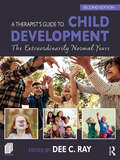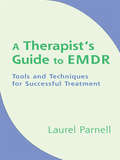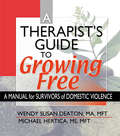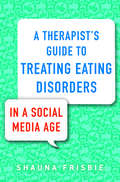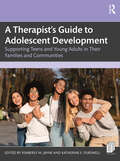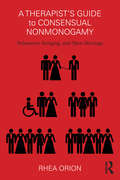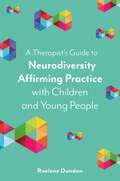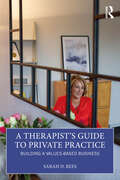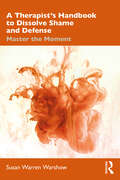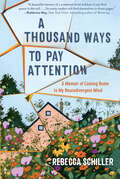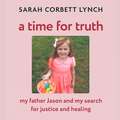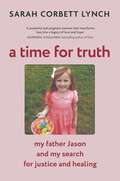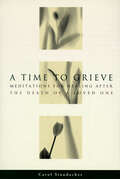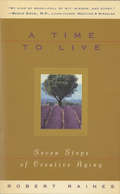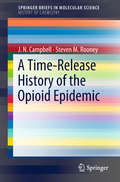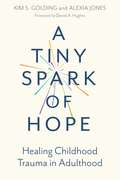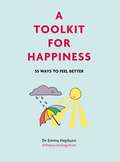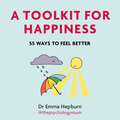- Table View
- List View
A Therapist's Guide to Child Development: The Extraordinarily Normal Years
by Dee C. RayA Therapist's Guide to Child Development gives therapists and counselors the basics they need to understand their clients in the context of development and to explain development to parents. The chapters take the reader through the various physical, social, and identity developments occurring at each age, explaining how each stage of development is closely linked to mental health and how that is revealed in therapy. This ideal guide for students, as well as early and experienced professionals, will also give readers the tools to communicate successfully with the child’s guardians or teachers, including easy-to-read handouts that detail what kind of behaviors are not cause for concern and which behaviors mean it’s time to seek help. As an aid to practitioners, this book matches developmental ages with appropriate, evidence-based mental health interventions.
A Therapist's Guide to Child Development: The Extraordinarily Normal Years
by Dee C. RayA Therapist's Guide to Child Development gives therapists and counselors the basics they need to understand their clients in the context of development and to explain development to parents.The chapters take the reader through the various physical, social, and identity developments occurring at each age, explaining how each stage of development is closely linked to mental health and how that is revealed in therapy. This ideal guide for students, as well as early and experienced professionals, will also give readers the tools to communicate successfully with the child’s caregivers or teachers, including easy-to-read handouts that detail what kind of behaviors are not cause for concern and which behaviors mean it’s time to seek help. In the new edition, each chapter also includes new sections on brain development and cultural identity development, as well as updates on child development in the age of technology.As an aid to practitioners, this book matches developmental ages with appropriate, evidence-based mental health interventions.
A Therapist's Guide to EMDR: Tools and Techniques for Successful Treatment
by Laurel ParnellA Therapist's Guide to EMDR reviews the theoretical basis for EMDR and presents new information on the neurobiology of trauma. It provides a detailed explanation of the procedural steps along with helpful suggestions and modifications. Areas essential to successful utilization of EMDR are emphasized. These include: case conceptualization; preparation for EMDR trauma processing, including resource development and installation; target development; methods for unblocking blocked processing, including the creative use of interweaves; and session closure. Case examples are used throughout to illustrate concepts. The emphasis in this book is on clinical usefulness, not research. This book goes into the therapy room with clinicians who actually use EMDR, and shows readers how to do it in practice, not just in theory. In short, this is the new, practical book on EMDR.
A Therapist's Guide to Growing Free: A Manual for Survivors of Domestic Violence
by Michael Hertica Wendy Susan DeatonHelp victims and survivors break the cycle of abuse!Trying to get victims and survivors of domestic abuse to recognize their own victimization can be a frustrating experience. They often become so frightened, isolated, and self-doubting that they make excuses for the abuser. Combining psychological insight with practical safety information, this book helps therapists guide their clients into understanding--and ending--the vicious cycle of wooing, tension, violence, and remorse. A Therapist's Guide to Growing Free provides a comprehensive outline of the issues, tasks, and goals involved in the treatment of victims and survivors. Its chapter-by-chapter breakdown of how violent relationships function and how to end them safely can help you guide a traumatized woman through her therapeutic journey.The guide's companion volume, Growing Free: A Manual for Survivors of Domestic Violence is the perfect handout for clients in individual therapy, group therapy, and battered women's shelters. Reading stories like their own may provide the shock of recognition they need to be able to understand--and eventually to end--the cycle of violence that characterizes all levels of domestic abuse. It outlines a series of steps they can take to ensure their emotional and physical safety. Its stories of women in abusive relationships and discussions of the cycle of abuse are direct and easy to read without ever being condescending.A Therapist's Guide to Growing Free provides the insight and therapeutic models needed for effective intervention and treatment, including: psychological effects and belief systems of victims and survivors discussions and illustrations of the cycle of violence the effects of domestic violence on children and adolescents the therapeutic challenges of couple/conjoint therapy handling crisis intervention suggestions for conducting group and therapeutic therapy for victim and battererA Therapist's Guide to Growing Free and its companion volume provide both therapists and clients with a practical, action-oriented approach to the problem of domestic violence. It is ideal training and reference material for counselors at women's shelters, emergency room personnel, law-enforcement officers, and other professionals involved in the rescue, support, defense, and treatment of victims and survivors.
A Therapist's Guide to Treating Eating Disorders in a Social Media Age
by Shauna FrisbieAn innovative therapeutic approach for counteracting the impact of social media on eating disorders and identity formation. All humans need space to think, to be, and to process without constant distraction. This is especially true of adolescents and young adults, for whom identity formation is a consuming task. Social media has generated both a place for the creation of identity and an audience. But constant connection leaves little space without intrusion from others. For those with body dissatisfaction and/or eating disorders, living in today’s world can be especially challenging, and viewing images on social media and other online formats can be devastating. Shauna Frisbie utilizes phototherapy techniques to view client-selected images (whether they be of themselves or others) to help uncover underlying messages that are impacting their relationship to their bodies. Integrating concepts of healing narratives, neuroscience, and phototherapy, this book will help any therapist promote self-compassion, self-reflection, and healing in their clients.
A Therapist’s Guide to Adolescent Development: Supporting Teens and Young Adults in Their Families and Communities
by Kimberly M. Jayne Katherine E. PurswellA Therapist’s Guide to Adolescent Development is a practical guide to understanding adolescent development and applying that knowledge in therapeutic practice.Chapters explore development and therapeutic considerations for specific age ranges in pre-adolescence and early, middle, and late adolescence. The final chapter includes reproducible, age-specific handouts about adolescent development for use by counselors and therapists to educate and collaborate with adolescents and their significant adults, including parents, caregivers, teachers, and mentors. Clinical examples representing diverse clients are provided throughout the book to support culturally sustaining practice and practical application.This unique and meaningful book will benefit any mental health professional or student who wants to integrate developmental knowledge into practice in a way that educates, empowers, and promotes collaboration with adolescents rather than pathologizing them.
A Therapist’s Guide to Consensual Nonmonogamy: Polyamory, Swinging, and Open Marriage
by Rhea OrionConsensual nonmonogamy (CNM) means that all partners in a relationship consent to expanded monogamy or polyamory. Clinicians are on the front line in providing support for the estimated millions pioneering these modern relationships. This first available guide for therapists provides answers to prevalent questions: What is the difference between expanded monogamy and polyamory? Is CNM healthy and safe? Why would someone choose the complexities of multiple partners? What about the welfare of children? Through illustrative case studies from research and clinical practice, therapists will learn to assist clients with CNM agreements, jealousy, sex, time, family issues, and much more. A Therapist's Guide to Consensual Nonmonogamy serves as a step forward toward expanding standard clinical training and helps inform therapists who wish to serve the CNM population.
A Therapist’s Guide to Neurodiversity Affirming Practice with Children and Young People
by Raelene DundonIn this honest and practical guide, autistic therapist Raelene Dundon explores and demystifies how neurodiversity affirming principles can be easily applied to therapeutic practice.Covering essential considerations for working with neurodivergent clients such as presuming competence, promoting autonomy and respecting communication styles, and providing advice on the best affirming approaches in therapy including how to accommodate sensory needs and encourage self-advocacy, Raelene provides easy-to-implement ways to make your practice inclusive and empowering for neurodivergent children and young people.The deficit model is out. It's time to become neurodiversity affirming.
A Therapist’s Guide to Private Practice: Building a Values-based Business
by Sarah ReesThis book is a comprehensive guide to setting up, running and growing a successful private therapy practice that resonates with your values and professional goals.Guiding you through every detail, from making the initial decision to set up your own private therapy practice to scaling your practice, this guide will support you in overcoming the common challenges you may encounter. It is filled with practical exercises, templates and checklists, including business planning actions at the end of each chapter so you can craft your first business plan. Ensuring you have a solid foundation and can shape a private therapy practice that meets your financial and personal needs while reflecting the passion that led you to your profession.A motivational and inspiring read for therapists, psychotherapists, coaches, and counselors. Get ready to turn your dream into reality and create something profoundly impactful and uniquely yours.
A Therapist’s Guide to Writing in Psychotherapy: Assessment, Documentation, and Intervention
by Michael D. ReiterThis guide practically aids mental health professionals in understanding and improving their therapeutic and academic writing, demonstrating how the written word is an invaluable tool to document, assess, and promote change with those in and outside the therapy room. Exploring the various ways writing occurs in psychotherapy professions, Michael D. Reiter comprehensively covers the range of the written word, from progress notes and assessment documentation, to journaling and therapeutic letters, as well as contacting larger systems such as report writing and grant applications. Chapters are formatted to include the purpose and function of a particular type of writing before providing multiple examples so therapists can apply this in their own practice. This book aims to help all therapists, regardless of academic training or therapeutic modality, to incorporate these ideas into their work. This book is designed for mental health professionals in a variety of settings, including counselors, therapists, social workers, family therapists, and clinical psychologists. This book is useful for graduate students as well as those already in practice.
A Therapist’s Handbook to Dissolve Shame and Defense: Master the Moment
by Susan Warren WarshowThe effort to surmount shame and formidable defenses in psychotherapy can trigger shame and self-doubt in therapists. Susan Warren Warshow offers a user-friendly-guide to help therapists move past common treatment barriers. This unique book avoids jargon and breaks down complex concepts into digestible elements for practical application. The core principles of Dynamic Emotional Focused Therapy (DEFT), a comprehensive treatment approach for demonstrable change, are illustrated with rich and abundant clinical vignettes. This engaging, often lyrical handbook emphasizes "shame-sensitivity" to create the safety necessary to achieve profound interpersonal connection. Often overlooked in treatment, shame can undermine the entire process. The author explains the "therapeutic transfer of compassion for self," a relational phenomenon that purposefully generates affective expression. She introduces a three-step, robust framework, The Healing Triad, to orient therapists to intervene effectively when the winds of resistance arise. Chapters clarify: Why we focus on feelings How to identify and move beyond shame and anxiety How to transform toxic guilt into reparative actions How to disarm defenses while avoiding ruptures This book is essential reading for both advanced and newly practicing mental health practitioners striving to access the profound emotions in their clients for transformative change.
A Thousand Days of Wonder
by Charles FernyhoughA father's intimate look at his daughter's developing mind from birth to age three Unlike any other time in our lives, we remember almost nothing from our first three years. As infants, not only are we like the proverbial blank slate but our memories are like teflon: nothing sticks. In this beautifully written account of his daughter's first three years, Charles Fernyhough combines his vivid observations with a synthesis of developmental theory, re-creating what that time, lost to the memory of adults, is like from a child's perspective. In A Thousand Days of Wonder, Fernyhough, a psychologist and novelist, attempts to get inside his daughter's head as she acquires all the faculties that make us human, including social skills, language, morality, and a sense of self. Written with a father's tenderness and a novelist's empathy and style, this unique book taps into a parent's wonder at the processes of psychological development.
A Thousand Plateaus: Capitalism and Schizophrenia
by Gilles Deleuze Felix GuattariPostmodern analysis of the culture of late capitalism.
A Thousand Ways to Pay Attention: Discovering The Beauty Of My Adhd Mind--a Memoir
by Rebecca SchillerNow in paperback: A captivating, heralded memoir, "unflinching and full of truth" (Katherine May), of a woman making a home on a small farm while grappling with an unexpected ADHD diagnosis “When you think about ADHD . . . do you picture a woman in the bucolic English countryside, raising her children along with an assortment of animals and vegetables? Why not?”—Salon Moving to a small farm is Rebeca Schiller’s dream come true. But as her young family adjusts to a new life in the countryside, her dream is threatened by something within. I’m aware of everything, all at once, which is too much. As Rebecca’s symptoms mount—frequent falls, rages, and strange lapses in memory—her doctors are baffled and her family unmoored. Finally comes a diagnosis: severe ADHD. For Rebecca, it is the start, not the end, of a quest for understanding. As she scrambles to support both family and farm, her focus spirals: from our current climate crisis to long-extinct lynx in the shadows of ancient oaks and the forgotten women who tended this land before her, their stories hidden just beneath the surface of history. In this luminous, heralded memoir of one woman’s newfound neurodivergence, attention is not deficient—but abundant. Publisher’s Note: A different version of this book has been published under the title Earthed in the United Kingdom.
A Time for Truth: My Father Jason and My Search for Justice and Healing
by Sarah Corbett Lynch'A powerful and poignant memoir that transforms loss into a legacy of love and hope' Katriona O'Sullivan, bestselling author of PoorAt approximately 3.15 a.m. on 2 August 2015, eight-year-old Irish girl Sarah Corbett Lynch was lifted from her bed by a Davidson County police officer and carried downstairs, shielded from the chaos that had broken out around her.Hours passed before Sarah learned that her beloved father Jason was dead. And the people who killed him were Sarah's stepmother Molly Martens and her father Tom.Now Sarah tells her story for the first time and reveals the startling truth of life behind closed doors in her family's suburban North Carolina home.Sarah recalls the weeks and months leading up to that night in August, and the use of manipulation and gaslighting by Molly Martens - the only mother she had ever known. She describes the traumatic years after her father's death as she and her brother Jack fought for justice from the safety of their new loving home in Limerick, Ireland, with Jason's family.A Time for Truth is a unique testimony of devastation, survival and hope, against the odds.
A Time for Truth: My Father Jason and My Search for Justice and Healing - as seen in documentary A Deadly American Marriage
by Sarah Corbett LynchA shocking true story of heartbreak and survival by Sarah Corbett Lynch, daughter of Jason Corbett - an Irish Times Number 1 bestseller and now the subject of NETFLIX documentary A DEADLY AMERICAN MARRIAGE.'Honest and compelling' Sunday Independent'Powerful, heartbreaking' Irish Times'An enthralling read' Irish Daily Mail'A powerful and poignant memoir that transforms loss into a legacy of love and hope' Katriona O'Sullivan, bestselling author of PoorAt approximately 3.15 a.m. on 2 August 2015, eight-year-old Irish girl Sarah Corbett Lynch was lifted from her bed by a Davidson County police officer and carried downstairs, shielded from the chaos that had broken out around her.Hours passed before Sarah learned that her beloved father Jason was dead. And the people who killed him were Sarah's stepmother Molly Martens and her father Tom.Now Sarah tells her story for the first time and reveals the startling truth of life behind closed doors in her family's suburban North Carolina home.Sarah recalls the weeks and months leading up to that night in August, and the use of manipulation and gaslighting by Molly Martens - the only mother she had ever known. She describes the traumatic years after her father's death as she and her brother Jack fought for justice from the safety of their new loving home in Limerick, Ireland, with Jason's family.A Time for Truth is a unique testimony of devastation, survival and hope, against the odds.
A Time for Truth: My Father Jason and My Search for Justice and Healing - as seen in documentary A Deadly American Marriage
by Sarah Corbett LynchA shocking true story of heartbreak and survival by Sarah Corbett Lynch, daughter of Jason Corbett - an Irish Times Number 1 bestseller and now the subject of NETFLIX documentary A DEADLY AMERICAN MARRIAGE.'Honest and compelling' Sunday Independent'Powerful, heartbreaking' Irish Times'An enthralling read' Irish Daily Mail'A powerful and poignant memoir that transforms loss into a legacy of love and hope' Katriona O'Sullivan, bestselling author of PoorAt approximately 3.15 a.m. on 2 August 2015, eight-year-old Irish girl Sarah Corbett Lynch was lifted from her bed by a Davidson County police officer and carried downstairs, shielded from the chaos that had broken out around her.Hours passed before Sarah learned that her beloved father Jason was dead. And the people who killed him were Sarah's stepmother Molly Martens and her father Tom.Now Sarah tells her story for the first time and reveals the startling truth of life behind closed doors in her family's suburban North Carolina home.Sarah recalls the weeks and months leading up to that night in August, and the use of manipulation and gaslighting by Molly Martens - the only mother she had ever known. She describes the traumatic years after her father's death as she and her brother Jack fought for justice from the safety of their new loving home in Limerick, Ireland, with Jason's family.A Time for Truth is a unique testimony of devastation, survival and hope, against the odds.
A Time to Grieve: Meditations for Healing After the Death of a Loved One
by Carol StaudacherA collection of truly comforting, down-to-earth thoughts and meditations -- including the authentic voices of survivors -- for anyone grieving the loss of a loved one.
A Time to Live
by Robert RainesIn A Time To Live, Robert Raines explores the spiritual and emotional dimensions of what can be the most rewarding time of life. Drawing on his experiences as an ordained minister and as director of a non-denominational retreat center focusing on issues of personal growth, Raines delineates the important passages we must all make from our middle years in the process of growing older. In an approach that is both meditative and inspirational, drawing from a variety of backgrounds, anecdotes, and literature, Raines provides a new perspective on the aging process and its implications. To make the most of this ultimate period of life, he argues, we must each confront certain issues: waking up to mortality, embracing sorrow, savoring blessedness, re-imagining work, nurturing intimacy, seeking forgiveness, and taking on the mysterious process of exploring what is yet to be done in life with a sense of possibility and hope. For the millions of baby boomers just entering their fifties and others approaching their sixties who are determined to be aware and take advantage of the challenges they face, A Time To Live, is the only book to directly address their needs. Sure to be a welcome and important spiritual guide for many, it offers the possibility of fulfillment and personal satisfaction.
A Time-Release History of the Opioid Epidemic (SpringerBriefs in Molecular Science)
by Steven M. Rooney J. N. CampbellThis Brief takes the reader on a chemical journey by following the history for over two centuries of how an opiate became an opioid, thus spawning an empire and a series of crises. These imperfect resemblances of alkaloids are both natural and synthetic substances that, particularly in America, are continually part of a growing concern about overuse. This seemed an inviting prospect for those in pain, but as the ubiquitous media coverage continues to lay bare, the levels of abuse point to the fact that perhaps an epidemic is upon us, if not a culture war. Seeking answers to how and why this addiction crisis transpired over two hundred years of long development, this Brief examines the role that the chemistry laboratory played in turning patients into consumers. By utilizing a host of diverse sources, this Brief seeks to trace the design and the production of opioids and their antecedents over the past two centuries. From the isolation and development of the first alkaloids with morphine that relieved pain within the home and on the battlefield, to the widespread use of nostrums and the addiction crisis that ensued, to the dissemination of drugs by what became known as Big Pharma after the World Wars; and finally, to competition from home-made pharmaceuticals, the progenitor was always, in some form, a type of chemistry lab. At times, the laboratory pressed science to think deeply about society's maladies, such as curing disease and alleviating pain, in order to look for new opportunities in the name of progress. Despite the best intentions opioids have created a paradox of pain as they were manipulated by creating relief with synthetic precision and influencing a dystopian vision. Thus, influence came in many forms, from governments, from the medical community, and from the entrepreneurial aspirations of the general populace. For better, but mostly for worse, all played a role in changing forever the trajectory of what started with the isolation of a compound in Germany. Combining chemistry and history in a rousing new long-form narrative that even broadens the definition of a laboratory, the origins and future of this complicated topic are carefully examined.
A Tiny Spark of Hope: Healing Childhood Trauma in Adulthood
by Kim Golding Alexia JonesI could not ignore the tiny spark of hope that whispered to me that there might be someone with whom I could be vulnerable and real, and that this time they might just not let me down...This is the story of Alexia and her therapist Kim, and their three-year therapy journey to begin Alexia's path to recovery. Written from both perspectives, it is a powerful and revealing account of a therapist-client relationship. Together, the authors show the manifold challenges that adult survivors of childhood abuse have to overcome, and offer insight to all therapists on how relational interventions can pave a way to healing.
A Tool for Determining e-Learning Readiness (SpringerBriefs in Educational Communications and Technology)
by Katherine Cennamo Cathy James-SpringerThis book presents a tool to determine e-learning readiness in workplace organizations. It offers a case study of the design and development process and outlines factors to be taken into account to determine e-learning readiness. It details the four objectives of this tool: to highlight specific parameters for determining e-learning readiness, to provide a systematic process to determine the readiness of an organization, to enable flexibility for the environmental context, and to capture the interrelatedness of the many areas in the organization. Next, it discusses the main element of the tool: surveys that are used to facilitate collection of data on organizational, learner and technology readiness. The book concludes with a look at practical ways of using the information gathered from the data produced.
A Toolkit for Happiness: 55 Ways to Feel Better
by Dr Emma Hepburn'Mandatory for anyone with a brain' - Anna Whitehouse, founder of Mother Pukka'Relatable, practical and knowledgeable' - Gemma Bray, creator of The Organised Mum Method From clinical psychologist and author of A Toolkit for Modern Life, Dr Emma Hepburn, comes A Toolkit for Happiness - the ultimate guide to long-term and sustainable happiness.Using her much-loved trademark illustrations, Dr Hepburn arms us with 55 accessible and easy-to-use tools to boost our moods and feel better. She teaches us that happiness is as much about weathering the storms of life, accepting its natural ebbs and flows, as it is about enjoying the sunny weather - and that by implementing small and simple changes we can build a more compassionate brain that carries us through our daily lives, no matter the weather.From practical tools to aid you on those extra stormy days to thought-provoking exercises for your day-to-day mental wellbeing, A Toolkit for Happiness will you to cultivate positive habits, better understand your emotions and put you on the path to a healthier and happier you.
A Toolkit for Happiness: 55 Ways to Feel Better
by Dr Emma Hepburn'Mandatory for anyone with a brain' - Anna Whitehouse, founder of Mother Pukka'Relatable, practical and knowledgeable' - Gemma Bray, creator of The Organised Mum Method From clinical psychologist and author of A Toolkit for Modern Life, Dr Emma Hepburn, comes A Toolkit for Happiness - the ultimate guide to long-term and sustainable happiness.Using her much-loved trademark illustrations, Dr Hepburn arms us with 55 accessible and easy-to-use tools to boost our moods and feel better. She teaches us that happiness is as much about weathering the storms of life, accepting its natural ebbs and flows, as it is about enjoying the sunny weather - and that by implementing small and simple changes we can build a more compassionate brain that carries us through our daily lives, no matter the weather.From practical tools to aid you on those extra stormy days to thought-provoking exercises for your day-to-day mental wellbeing, A Toolkit for Happiness will you to cultivate positive habits, better understand your emotions and put you on the path to a healthier and happier you.
A Toolkit for Happiness: 55 Ways to Feel Better
by Emma Hepburn'Mandatory for anyone with a brain' - Anna Whitehouse, founder of Mother Pukka'Relatable, practical and knowledgeable' - Gemma Bray, creator of The Organised Mum Method From clinical psychologist and author of A Toolkit for Modern Life, Dr Emma Hepburn, comes A Toolkit for Happiness - the ultimate guide to long-term and sustainable happiness.Using her much-loved trademark illustrations, Dr Hepburn arms us with 55 accessible and easy-to-use tools to boost our moods and feel better. She teaches us that happiness is as much about weathering the storms of life, accepting its natural ebbs and flows, as it is about enjoying the sunny weather - and that by implementing small and simple changes we can build a more compassionate brain that carries us through our daily lives, no matter the weather.From practical tools to aid you on those extra stormy days to thought-provoking exercises for your day-to-day mental wellbeing, A Toolkit for Happiness will you to cultivate positive habits, better understand your emotions and put you on the path to a healthier and happier you.

